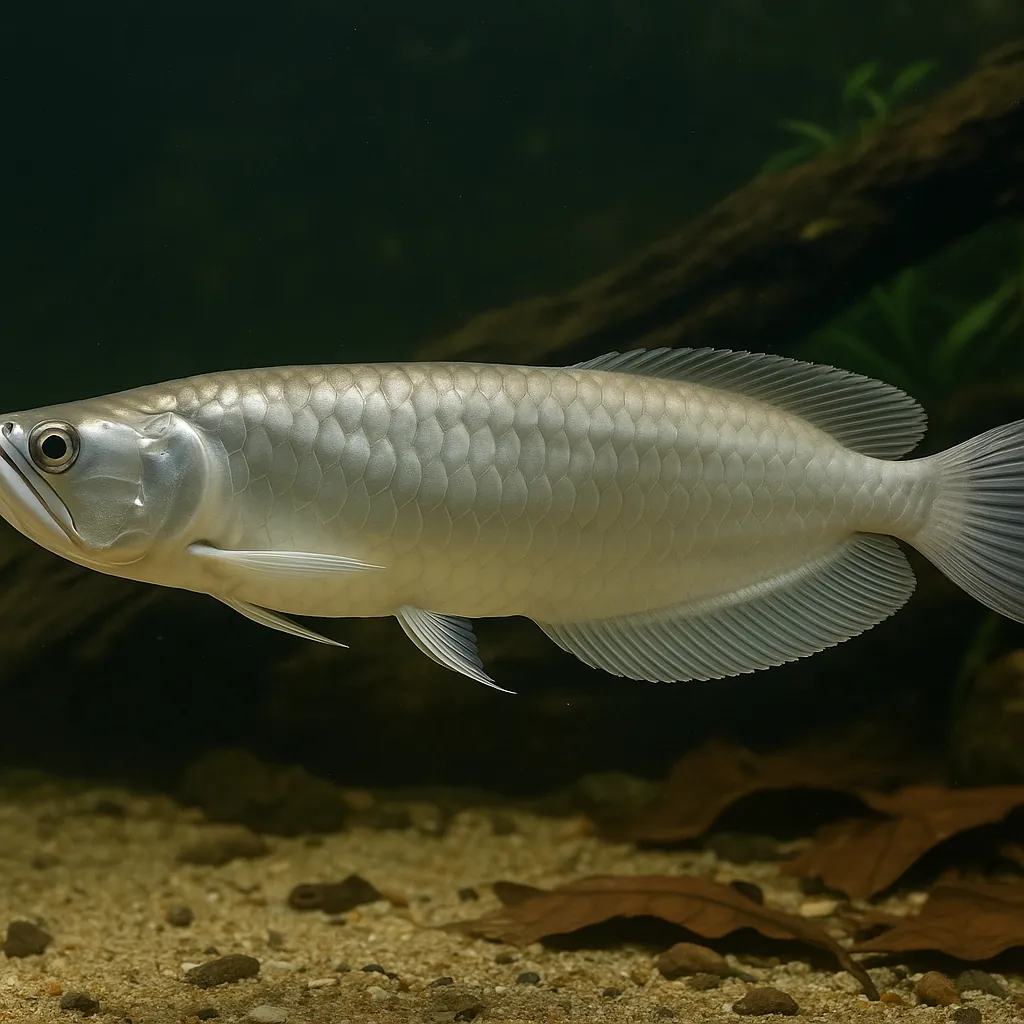
Silver arowana
Introduction
The Silver Arowana, often referred to as the "dragon fish," is a captivating freshwater species renowned for its sleek, metallic appearance and graceful swimming. Highly sought after by aquarists, this fish is both a visual centerpiece and a testament to the challenges of advanced fishkeeping. While its beauty is undeniable, the Silver Arowana demands meticulous care, making it more suitable for experienced hobbyists prepared to meet its specific needs.
What makes the Silver Arowana so appealing to aquarists?
Its shimmering silver scales and elongated body give it a dragon-like appearance, making it a striking addition to large aquariums.
Is the Silver Arowana suitable for beginner fishkeepers?
Due to its size and care requirements, it's best suited for experienced aquarists who can provide the necessary environment and attention.
Care and Environment
Proper care for the Silver Arowana involves creating an environment that accommodates its size and natural behaviors. Here's a comprehensive guide to ensure your Arowana thrives:
What is the minimum tank size required for a Silver Arowana?
A juvenile can start in a 250-liter tank, but as it grows, a minimum of 750 liters is recommended to provide ample swimming space.
What are the ideal water parameters for Silver Arowanas?
Maintain a temperature between 24-28°C, pH levels of 6.5-7.5, and water hardness of 1-8 dGH to mimic their natural habitat.
How should the tank be set up to prevent the Arowana from jumping out?
Ensure the tank has a secure, tightly fitting lid, as Silver Arowanas are known for their jumping ability.
What type of filtration system is best for Silver Arowanas?
A powerful canister filter is essential to handle the substantial waste produced and maintain pristine water quality.
What should be included in the tank's decor?
Opt for a bare-bottom or sparsely decorated tank with large, smooth rocks. Avoid sharp objects to prevent injury.
What is the recommended diet for Silver Arowanas?
They are carnivorous and thrive on a varied diet of live foods like feeder fish, crickets, and earthworms. Incorporating high-quality pellets can also provide balanced nutrition.
Are there any specific challenges in caring for Silver Arowanas?
They are sensitive to water quality and can be aggressive, especially during breeding. Regular monitoring and maintenance are crucial.
Origin and Habitat
Native to the freshwater rivers and floodplains of South America, the Silver Arowana inhabits regions such as the Amazon Basin. These environments are characterized by slow-moving waters, dense vegetation, and submerged roots, providing ample hiding spots and hunting grounds. Seasonal flooding expands their habitat, allowing them to explore flooded forests and access a diverse range of prey.
Where are Silver Arowanas naturally found?
They are indigenous to the Amazon River Basin in South America.
What type of environments do they prefer in the wild?
They thrive in slow-moving rivers and floodplains with dense vegetation and submerged structures.
Temperament and Compatibility
Silver Arowanas are known for their predatory nature and can exhibit territorial behavior. While they are generally solitary, they can coexist with certain tank mates under specific conditions.
Are Silver Arowanas aggressive towards other fish?
Yes, they can be aggressive, especially towards smaller fish that can fit into their mouths.
What types of tank mates are suitable for Silver Arowanas?
Large, robust fish like large cichlids, plecos, and certain catfish species can be compatible, provided the tank is spacious enough.
How can aggression be minimized in a community tank?
Ensuring ample space, providing hiding spots, and carefully selecting tank mates that occupy different tank regions can help reduce aggression.
Interesting Facts
The Silver Arowana boasts several intriguing traits that captivate aquarists:
- They are known as "dragon fish" due to their elongated bodies and metallic scales, symbolizing strength and prosperity in various cultures.
- In the wild, they exhibit remarkable jumping abilities, leaping out of the water to catch prey like insects and small birds perched on overhanging branches.
- Silver Arowanas are mouthbrooders; males carry fertilized eggs in their mouths until the fry are ready to swim freely.
Why are Silver Arowanas called "dragon fish"?
Their appearance resembles mythical dragons, and they are considered symbols of luck and prosperity.
How do Silver Arowanas catch prey in the wild?
They can leap out of the water to snatch prey from low-hanging branches.
What is unique about their breeding behavior?
Males protect and incubate the eggs in their mouths until the young are ready to swim independently.
Sources
All information in this article has been gathered from the following reputable sources:
Overview
Recommended Tank Size 264.2 Gallons (for optimal conditions) |
Minimum Group Size 1 |
Minimum Tank Volume 198.1 Gallons |
Maximum Adult Length 35.4 inches |
Average Adult Length 29.5 inches |
Shoaling (6+ required) No |
Preferred Water Type Freshwater, slightly acidic to neutral |
Temperature Range (°C) 24-28 |
pH Range 6.5-7.5 |
Water Hardness (dGH) 1-8 |
Typical Lifespan (years) 10 years |